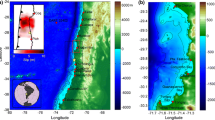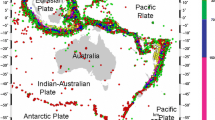Abstract
The catastrophic 2004 Indonesian tsunami reached the shores of Eastern Africa, where it affected at least 12 countries and caused several hundred casualties, principally in Somalia. Significant variations in run-up were documented by various post-tsunami surveys (note that the latter remain incomplete, especially in Southern Tanzania and Mozambique). In a previous study, Okal et al. (S Afr J Geology 112:343–358, 2009) suggested that these variations could depend on the precise location of the tsunami sources, as a result of the combined effect of source directivity and refraction by irregular bathymetry. In this context, we present the results of a significantly enhanced study, which considers a total of twelve potential sites of mega-earthquakes, along both the Sunda Arc, and the Makran subduction zone. Numerical simulations are carried out at a total of 35 virtual gauges, spanning the East African coast from Socotra in the North to Port Elizabeth in the South, as well as adjoining islands (Madagascar, Comoros, Mascarenes), the Gulf of Aden, and distant islands in the far Southern Indian Ocean, from Amsterdam to Prince Edward. We conclude that at many locations, in particular in Mozambique, South Africa, Madagascar, and the Mascarenes, the 2004 tsunami (which to a large extent awakened the awareness of the continent to tsunami danger) may not have represented a worst case scenario. For tsunamis originating in the Makran, amplitudes larger than in 1945 require the simultaneous rupture of several blocks of the plate boundary, a scenario which, although not impossible, remains at this stage speculative.





Similar content being viewed by others


References
Ambraseys NN, Melville CP (1982) A history of Persian earthquakes. Cambridge Univ Press, Cambridge
Ando M (1975) Source mechanism and tectonic significance of historical earthquakes along the Nankai Trough, Japan. Tectonophysics 27:119–140
Anonymous (2001) ETOPO2, Global 2 arc-minute ocean depth and land elevation from the US National Geophysical Data Center. NOAA, U.S. Dept Commerce, Washington, D.C
Anonymous (2005) United Nations Hyogo Declaration on Disaster Reduction, A/CONF.206/6, http://www.unhcr.org/refworld/docid/42b988b24.html
Anonymous (2015) Remembering the 1945 Makran tsunami. Intergov. Oceanog. Comm., UNESCO, Paris
Ben-Menahem A, Rosenman M (1972) Amplitude patterns of tsunami waves from submarine earthquakes. J Geophys Res 77:3097–3128
Bernard EN, Titov VV (2015) Evolution of tsunami warning systems and products. Phil Trans R Soc London Ser A 373:20140371, 14 p.
Borrero JC, Weiss R, Okal EA, Hidayat R, Suranto, Arcas D, Titov VV (2009) The tsunami of 2007 September 12, Bengkulu Province, Sumatra, Indonesia: Post-tsunami survey and numerical modeling. Geophys J Intl 178:180–194
Burbidge DR, Cummins PR, Mleczko R, Latief H, Mokhtari M, Natawidjaja D, Rajendran CP, Thomas C (2009) A probabilistic tsunami hazard assessment of the Indian Ocean nations. Geosci Australia Prof Opin 2009/11
Cisternas M, Atwater BF, Torrejón F, Sawai Y, Machuca G, Lagos M, Eipert A, Youlton C, Salgado I, Kamatabi T, Shishikura M, Rajendran CP, Malik JK, Rizal Y, Husni M (2005) Predecessors of the giant 1960 Chile earthquake. Nature 437:404–407
Courant R, Friedrichs K, Lewy H (1928) Über die partiellen Differenzengleichungen der mathematischen Physik. Math Ann 100:32–74
Davies G, Griffin J, Løvholt F, Glimsdal S, Harbitz V, Thio HK, Lorito S, Basili R, Selva J, Geist E, Baptista MA (2018) A global probabilistic tsunami hazard assessment from earthquake sources. Geol Soc London Spec Pub 456:219–244
Derakhti M, Dalrymple RA, Okal EA, Synolakis CE (2019) Temporal and topographic source effects in tsunami generation. J Geophys Res Oceans 124:5270–5288
Fritz HM, Borrero JC (2006) Somalia field survey after the December 2004 Indian Ocean tsunami. Earthquake Spectra 22:S219–S233
Fritz HM, Okal EA (2008) Socotra Island, Yemen: Field survey of the 2004 Indian Ocean tsunami. Nat Hazards 46:107–117
Fritz HM, Synolakis CE, McAdoo BG (2006) Maldives field survey after the December 2004 Indian Ocean tsunami. Earthquake Spectra 22:S137–S154
Godunov SK (1959) Finite difference methods for numerical computations of discontinuous solutions of the equations of fluid dynamics. Matematicheskiı̆ Sbornik 47:271–295
Green G (1838) On the motion of waves in a variable canal of small depth and width. Trans Cambridge Philos Soc 6:457–462
Heidarzadeh M, Satake K (2015) New insights into the source of the Makran tsunami of 27 November 1945 from tsunami waveforms and coastal deformation data. Pure Appl Geophys 172:621–640
Heidarzadeh M, Pirooza MD, Zakerb NH, Yalçıner AC, Mokhtari M, Esmaeilye A (2008) Historical tsunami in the Makran Subduction Zone off the southern coasts of Iran and Pakistan and results of numerical modeling. Ocean Eng 35:774–786
Jackson LE, Barrie JV, Forbes DL, Shaw J, Mawson GK, Schmidt M (2005) Effects of the 26 December 2004 Indian Ocean tsunami in the Republic of Seychelles. Eos, Trans Amer Geophys Un 86 (52):F6–F7 [abstract]
Jankaew K, Atwater BF, Sawai Y, Choowong M, Charoentitrat M, Martin MF, Prendergast A (2008) Medieval forewarning of the 2004 Indian Ocean tsunami in Thailand. Nature 455:1228–1231
Kelsey HM, Nelson AR, Hemphill-Haley E, Witter RC (2005) Tsunami history of an Oregon coastal lake reveals a 4600-yr record for great earthquakes on the Cascadia subduction zone. Geol Soc Amer Bull 117:1009–1032
Kukowski N, Schillhorn T, Flueh ER, Hurn K (2000) Newly identified strike-slip plate boundary in the Northeastern Arabian Sea. Geol 28:355–358
Mansinha L, Smylie DE (1971) The displacement fields of inclined faults. Bull Seismol Soc Amer 61:1433–1440
Maselli V, Oppo D, Moore AL, Gusman AR, Mtelela C, Iacopini D, Taviani M, Mjerna E, Mulaya E, Che M, Tomioka AL, Mshiu E, Ortiz JD (2020) A 1000-yr-old tsunami in the Indian Ocean points to greater risk for East Africa. Geology 48:808–813
McCloskey J, Lange D, Tilmann F, Nalbant SS, Bell AF, Natawidjaja DH, Rietbock A (2010) The September 2009, Padang earthquake. Nature Geosci 3:70–71
Mokhtari M, Fard IA, Hessami K h (2008) Structural elements of the Makran region, Oman Sea and their potential relevance to tsunamigenesis. Nat Hazards 47:185–199
Musson RMW (2009) Subduction in the Western Makran: the historian’s contribution. J Geol Soc London 166:387–391
Nanayama F, Satake K, Furukawa R, Shimokawa K, Atwater BF, Shigeno K, Yamaki S (2003) Unusually large earthquakes inferred from tsunami deposits along the Kuril trench. Nature 424:660–663
Natawidjaja D, Sieh K, Chlieh M, Galetzka J, Suwargadi B, Cheng H, Edwards RL, Avouac J -P, Ward S (2006) Source parameters of the great Sumatran earthquakes of 1797 and 1833 inferred from coral microatolls. J Geophys Res 111(B6):B06403, 37 p
Okal EA, Synolakis CE (2008) Far-field tsunami hazard from mega-thrust earthquakes in the Indian Ocean. Geophys J Intl 172:995–1015
Okal EA, Fritz HM, Raveloson R, Joelson G, Pančošková P, Rambolamanana G (2006a) Madagascar field survey after the December 2004 Indian Ocean tsunami. Earthquake Spectra 22:S263–S283
Okal EA, Fritz HM, Raad PE, Synolakis CE, Al-Shijbi Y, Al-Saifi M (2006b) Oman field survey after the December 2004 Indian Ocean tsunami. Earthquake Spectra 22:S203–S218
Okal EA, Sladen A, Okal E A -S (2006c) Rodrigues, Mauritius and Réunion Islands field survey after the December 2004 Indian Ocean tsunami. Earthquake Spectra 22:S241–S261
Okal EA, Fritz HM, Sladen A (2009) 2004 Sumatra tsunami surveys in the Comoro Islands and Tanzania and regional tsunami hazard from future Sumatra events. S Afr J Geol 112:343–358
Okal EA, Fritz HM, Hamzeh MA, Ghasemzadeh J (2015) Field survey of the 1945 Makran and 2004 Indian Ocean tsunamis in Baluchistan Iran. Pure Appl Geophys 172:3343–3356
Oldham RD (1893) A manual of the geology of India: stratigraphical and structural geology. Off. Superint. Gov. Printer, Calcutta.
Pendse CG (1948) The Mekran earthquake of the 28th November 1945. India Meteorol Dept Sci Notes 10:141–146
Rabinovich AB (1997) Spectral analysis of tsunami waves: separation of source and topography effects. J Geophys Res 102:12663–12676
Rabinovich AB, Thomson RE (2007) The 26 December 2004 Sumatra tsunami: analysis of tide gauge data from the world ocean; Part 1. Indian Ocean and South Africa. Pure Appl Geophys 164:261–308
Rajendran CP, Rajendran K, Machado T, Satyamurthy T, Aravazhi P, Jaiswal M (2006) Evidence of ancient sea surges at the Mamallapuram coast of India and implications for previous Indian Ocean tsunami events. Curr Sci 91:1242–1247
Rajendran CP, Rajendran K, Shah-Hosseini M, Naderi-Beni A, Nautiyal CM, Andrews R (2013) The hazard potential of the western segment of the Makran subduction zone, northern Arabian Sea. Nat Hazards 65:219–239
Reymond D, Okal EA (2000) Preliminary determination of focal mechanisms from the inversion of spectral amplitudes of mantle waves. Phys Earth Planet Inter 121:249–271
Saito T, Furumura T (2009) Three-dimensional tsunami generation simulation due to sea-bottom deformation and its interpretation based on the linear theory. Geophys J Intl 178:877–888
Satake K (1988) Effects of bathymetry on tsunami propagation: application of ray tracing to tsunamis. Pure Appl Geophys 126:27–36
Synolakis CE (2003) Tsunami and seiche. In: Chen W-F, Scawthron C (eds) Earthquake engineering handbook. CRC Press, Boca Raton, pp 9_1–9_90
Synolakis C, Bernard E, Titov V, Kânoğlu U, González F (2008) Validation and verification of tsunami numerical models. Pure Appl Geophys 165:2197–2228
Titov VV, Synolakis CE (1998) Numerical modeling of tidal wave runup. J Waterway Port Coast Oc Eng 124:157–171
Titov VV, Rabinovich AB, Mofjeld HO, Thomson RE, González FI (2005) The global reach of the 26 December 2004 Sumatra tsunami. Science 309:2045–2048
Titov VV, Kânoğlu U, Synolakis CE (2016) Development of MOST for real-time tsunami forecasting. J Waterway Port Coast Oc Eng 142(6):03116004, 16 p
Viera VM, Le Bohec C, Côté SD, Groscolas R (2006) Massive breeding failures following a tsunami in a colonial seabird. Polar Biol 29:713–716
Weiss R, Bahlburg H (2006) The coast of Kenya field survey after the December 2004 Indian Ocean tsunami. Earthquake Spectra 22:S235–S240
Wessel P, Smith WHF (1991) Free software helps map and display data. Eos, Trans Amer Un Geophys 72:441 and 445–446
White RS, Klitgord K (1976) Sediment deformation and plate tectonics in the Gulf of Oman. Earth Planet Sci Letts 32:199–209
Woods MT, Okal EA (1987) Effect of variable bathymetry on the amplitude of teleseismic tsunamis: a ray-tracing experiment. Geophys Res Letts 14:765–768
Zachariasen J, Sieh K, Taylor FW, Edwards RL, Hantoro WS (1999) Submergence and uplift associated with the giant 1833 Sumatran subduction earthquake: evidence from coral microatolls. J Geophys Res 104:895–919
Acknowledgments
We thank the conveners of the 2nd Conference of the Journal of Arabian Geosciences, Drs. Abdullah Al-Amri, Nabil Khelifi, and Mustapha Meghraoui, for their support. The paper was improved by the comments of three anonymous reviewers. Some figures were drafted using the GMT software (Wessel and Smith 1991).
Funding
This research was supported at the University of Michigan by the National Science Foundation under Grant 1663769 of the PREEVENTS program.
Author information
Authors and Affiliations
Corresponding author
Additional information
Communicated by: Santanu Banerjee
This paper was selected from the 2nd Conference of the Arabian Journal of Geosciences (CAJG), Tunisia 2019
Rights and permissions
About this article
Cite this article
Salaree, A., Okal, E.A. Tsunami simulations along the Eastern African coast from mega-earthquake sources in the Indian Ocean. Arab J Geosci 13, 1055 (2020). https://doi.org/10.1007/s12517-020-05893-8
Received:
Accepted:
Published:
DOI: https://doi.org/10.1007/s12517-020-05893-8


